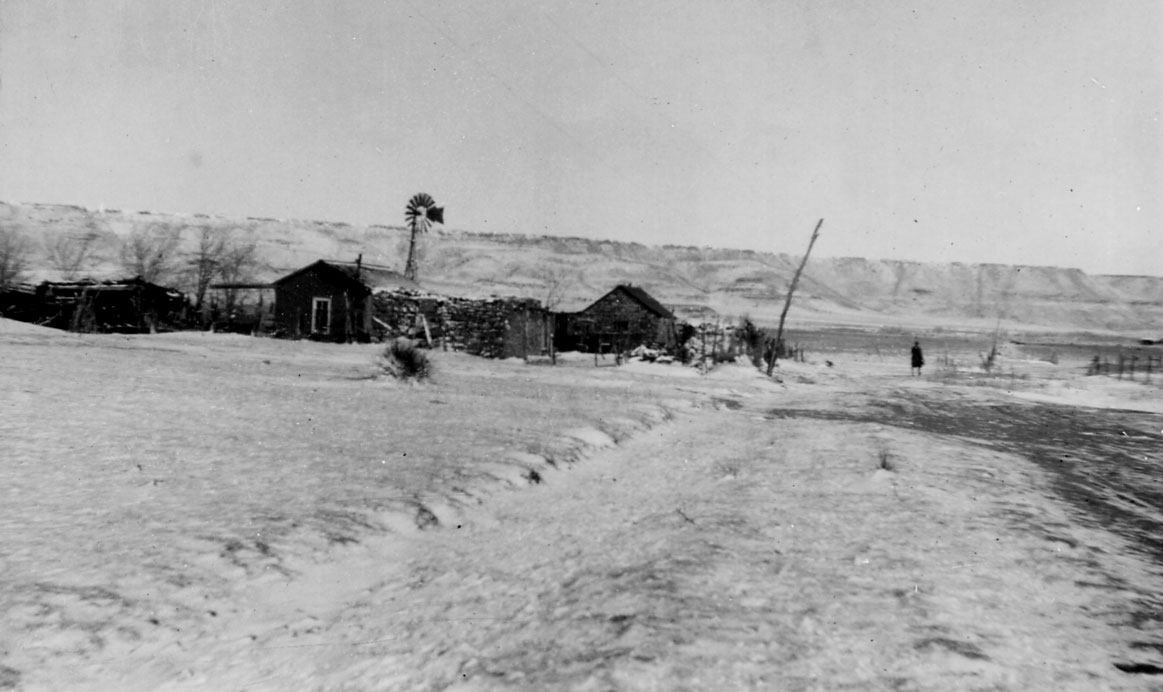BLACK MESA.
Located in far northwestern Cimarron County in the Oklahoma Panhandle at an elevation of 4,972.97 feet, the highest point in Oklahoma, the Black Mesa plateau has been called a geological wonder of North America. Here, the Rocky Mountains meet the shortgrass prairie. This three-million-year-old basalt lava flow, measuring fifty-five miles long, six hundred feet thick, and one-half to eight miles wide, originated from a Colorado volcano named Piney Mountain sixty-five miles north-northwest of Oklahoma. Nowhere else in Oklahoma has there been such recent volcanic activity. Since 1935 the location has provided geologists and paleontologists rare opportunities to examine Jurassic and Triassic rocks and the dinosaur bones in them. More than eighteen tons of camptosaurus, stegosaurus, brontosaurus, diplodocus, and edmontosaurus bones have been quarried at Black Mesa. A string of allosaurus footprints can be seen clearly along Carrizo Creek just north of the mesa itself.
In the nineteenth century outlaws such as William Coe and Blackjack Ketchum utilized the region as a hideout. Coe and his gang built a stone fortress called Robbers' Roost, which was reputedly complete with blacksmith shop, gun ports, and piano. Because No Man's Land, the present Oklahoma Panhandle, lacked law enforcement or a significant population at the time, outlaws easily avoided the reach of the law. When settlers, mainly cattle ranchers and coal and copper miners, arrived and demanded protection, the lawless element was subdued. Ranchers utilized the mesa for grazing their sheep and cattle and on a yearly basis participated in roundups to separate livestock and brand calves, and these activities continued at the beginning of the twenty-first century.
In 1959 Oklahoma created the 549-acre Black Mesa State Park, with cabins, camper hookups, a campground, a picnic area, and two-hundred-acre Lake Carl G. Etling. Fantastic natural rock formations, including Wedding Party, Wedding Cake, and Old Maid fascinate visitors, and cliffs and huge boulders challenge rock climbers. The park hosts a plethora of wildlife including golden eagles, piñon jays, red-tailed hawks, and mule deer. Black Mesa has been a destination for bird watchers, campers, hikers, and outdoor enthusiasts. Nearby Kenton, Oklahoma, the only Oklahoma community on Mountain Time, serves as a staging ground and supply point for visitors.
The mesa itself is protected as the Black Mesa Nature Preserve, established in 1991 when a private group, the Oklahoma Nature Conservancy, purchased the mesa. The preserve contains sixteen hundred acres and protects 60 percent of the mesa top. Only hikers are allowed, and they may reach the top of the mesa via an old, eight-mile-long jeep trail. Black Mesa has continued to be an outstanding Oklahoma destination with its legacies of prehistory, the Wild West, wildlife, and a pristine natural environment.
See Also
CIMARRON COUNTY, ENVIRONMENT AND CULTURAL ECOLOGY, MINING AND MINERALS, NO MAN'S LAND, PALEOENVIRONMENT, PREHISTORIC NATIVE PEOPLES
Bibliography
Black Mesa Nature Preserve (N.p.: The Nature Conservancy and Oklahoma Tourism and Recreation Department, n.d.).
Cimarron County, Oklahoma: Points of Interest and a Little History (Boise City, Okla.: Boise City Chamber of Commerce, n.d.).
The Cimarron Route of the Santa Fe Trail (Boise City, Okla.: Cimarron Cut-off Chapter of the Santa Fe Trail Association and the Cimarron County Historical Society, n.d.).
Norma Gene Young, Still Not a Stop Light in the County (Boise City, Okla.: Privately printed, 1997).
Citation
The following (as per The Chicago Manual of Style, 17th edition) is the preferred citation for articles:
Tom Lewis and Sara Jane Richter, “Black Mesa,” The Encyclopedia of Oklahoma History and Culture, https://www.okhistory.org/publications/enc/entry?entry=BL005.
Published January 15, 2010
Last updated
May 22, 2020
© Oklahoma Historical Society


